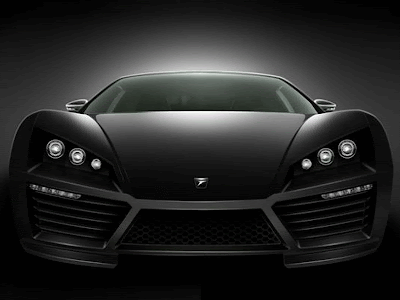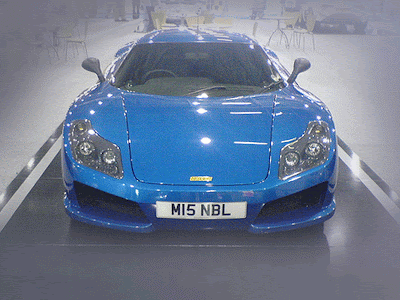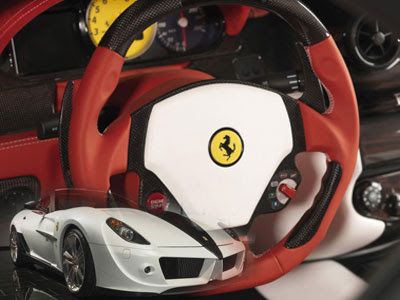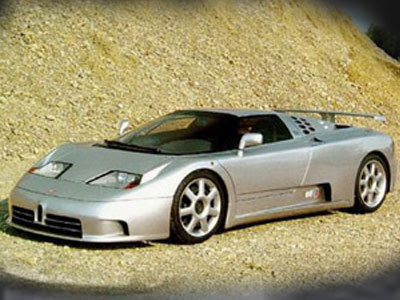Showing posts with label Super Cars. Show all posts
Showing posts with label Super Cars. Show all posts
ICONIC Motors answers with 2011 ICONIC AC Roadster, for those who crave unparalleled power and innovative performance. The 2011 ICONIC AC Roadster is designed from the ground up to be on of the world most completely refined and advanced super cars. Virtually no other vehicle in the planet has undergone the same kind of engineering development and attention to detail as the ICONIC AC Roadster.
2011 Iconic Motors Sports Car AC Roadster
Designed as the world’s most completely refined and advanced super cars, 2011 Iconic Motors AC Roadster has got styling cues from the legendary Shelby Cobra.Now American sports car company ICONIC Motors have partnered up with AC Cars and renamed the car AC Roadster. First revealed by AC Cars back in 2008 as the GTR Roadster, then unveiled in the flesh at last year's Top Marques Monaco event as the MkVI AC Cobra, ICONIC has partnered with AC to present the AC Roadster. The sports car a 6.9-liter V-8 rated at 800 horsepower married to a classic AC-styled roadster chassis weighing in at about 2,400 pounds. That's good for 60 mph in under three seconds, according to the company.
“The ICONIC AC Roadster is more than just a sports cars, it’s among the world’s most refined and beautifully designed super cars. It’s the lightest, strongest, most well engineered, high performance roadster of our time. The engine, drive train, support electronics and overall chassis make this one of the most complete vehicle packages on the market today and is made right here in the USA,” said Claudio Ballard, chairman and founder, ICONIC Motors.
This innovative process allows for ICONIC Motors to capture the look and style of timeless classic roadsters from the 1950's and ’60's, while infusing all of the modern technology and engineering available today, this super car is truly the first of its kind.
The 2011 ICONIC AC Roadster is the first of many uniquely designed modern era muscle cars that blend the legendary design cues of the past with the technology of the future. The sports cars is now available for order, with first deliveries to come in 2011.
Labels: 2011, ICONIC Motors, Sports Car, Super Cars
Fenix Supercar ultra-powerful mid-engined V8
Lee Noble’s love for cars remains as young as it used to be. I can say so because even when he left the company he built, Noble, his newest creation, Fenix supercar. Leicestershire – Lee Noble, the maverick designer and engineer who has defined the British low volume sports car market in recent years, is back in the hot seat of an all-new company, Fenix Automotive Limited, and is due to launch one of the most dramatic supercars of the century next year. Fenix Supercar ultra-powerful mid-engined V8
Fenix supercar is believed to be the sequel of the iconic M12 which was a great success but Fenix is a start from the scratch as far as the designing part is concerned. Fenix will be having two models for the grab whereby GM`s 480bhp LS3 V8 will be the `base` unit, while the 6.2-litre supercharged LS9 V8 will provide customers with a 638bhp power option. And powered with 638bhp engine, as Fenix claims, car will get from 0-100mph in less than seven seconds and go on to reach more than 200mph. Fenix Supercar ultra-powerful mid-engined V8
With successful production cars like the Noble M12 and M400 already under his belt (as well as the original Ultima and Ascari, among many others) Lee is investing his vast experience in delivering a lightweight, ultra-powerful mid-engined V8 supercar to market by the end of 2010.“Our new car will offer buyers performance and dynamics that they’d normally have to spend well over £100,000 to experience, but at a far more affordable price,” said Lee Noble. “It will combine simplicity, strength and agility, while its two-seat, closed body will ensure sensible levels of refinement for road use.
Fenix Supercar ultra-powerful mid-engined V8
With over 25 years’ experience in the low volume sports car market, Lee’s pragmatic approach to producing super-fast, giant-killing cars has won him credibility among buyers and the media alike. So while the first pictures of his new creation (due early next year) are sure to cause a stir, Lee’s grounded philosophy to manufacturing will ensure that the car is a production reality. In fact, development of the car began in earnest a year ago, and the first prototype, which will be used to validate the all-new chassis and powertrain, is currently being built in Port Elizabeth, South Africa, in the same plant that produced all the M12s.Fenix Supercar ultra-powerful mid-engined V8
Fenix supercar’s first edition will be launched in UK in the second half of the year whereas its prototype is under construction in South Africa. Lee believes that he can roll out 100 editions a year and it will cost somewhere around £70,000 per unit.
Labels: Fenix, Super Cars, V8
Fenix Supercar M14
Although the man has been separated from the company that bears his name for a while now, as we revealed when PH interviewed Lee Noble before Christmas he's still hard at work in the business of producing sports cars. Despite having left his namesake British supercar company Noble Automotive, Lee Noble is back in the game and plans to begin development on an all-new supercar.His new company is called Fenix Automotive and the first Fenix is planned to be a lightweight, mid-engine coupe that can capture a sub-seven-second 0 to 100 mph. The car will feature a powerful V8 engine and is intended to be ‘one of the most dramatic supercars of the century’ thanks in part to the moderate price tag of 75,000 pounds (app. $125K). Noble also mentioned an interesting feature that will make the first Fenix practical both on road and track, though apparently didn’t elaborate from there.
Fenix Supercar M15
The Fenix supercar prototype is currently in build at Fenix's facility in South Africa, and the car will do its initial hot-weather testing there before heading to the UK for further development.
"The M12 was hugely successful, but we needed to move the game on in terms of design," says Noble. "The new car's styling owes nothing to what I've done before and has quite literally been a 'clean sheet' exercise from the start. It's edgy, with powerful lines, and aerodynamically will be in another league to any of my previous cars."
Fenix Supercar M15
But despite Noble's protestations of a clean-sheet design, we can't help but think of the Fenix as the hoped for successor to the sharp, focused, track-honed M12 series, and that's no bad thing. That the looks seem to bear a passing resemblance to the stillborn M14 and M15 is far from a tragedy, too. The Fenix will be powered by an LS3 GM V8 pumping out 480bhp, while the truly power hungry can specify the 638bhp LS9 V8 as seen in the Corvette ZR1. Fenix reckons that the LS9-engined car should accelerate from 0-100mph in under seven seconds and hit a maximum of 200mph.
Fenix Supercar M15
"I always said I wanted to build a car with the performance of an Enzo for less than £100k, and that's what I'll deliver this time round," said Noble when we interviewed him, and it looks like he might manage it. The base model is expected to cost around £70k, with the supercharged version set to come in at less than £100k.
Labels: Fenix, Super Cars, V8
Ac Schnitzer ACS3 3.5d Sports Coupe, AC Schnitzer never tires of receiving awards. Very recently, the carmaker got a third world record for Aachen after having gone to Nardo in southern Italy. Third World Record in Succession: AC Schnitzer builds fastest diesel car! AC Schnitzer ACS3 3.5d Coupé reaches 288.7 km/h in Nardo. It's a hat-trick: for the third time, AC Schnitzer has gone to Nardo in southern Italy and brought home a third world record for Aachen.
Historically, many records are set in the high-speed circuit. Each year in southern Italy, in collaboration with the AUTO BILD sportscars’ editors and under the aegis of Continental AG, the top vehicle tuners compete. This year, it was on Oct. 18-19, 2009. The record for the fastest road-legal diesel car was broken by the AC Schnitzer ACS3 3.5d Coupe with a speed of more than 8.7 km/h.288.7 km/h.
This was the figure on the display of the GPS speedometer system on the 13 km long high-speed circuit after the lap of the AC Schnitzer ACS3 3.5d Coupé. The record that was broken had been that of 2006 with the TENSION as the fastest road-legal BMW. The record had held in 2007 when the GP3.10 GAS POWERED entered to represent gas-powered vehicles. AC Schnitzer cited its power upgrade as the reason for its success.
Naturally the power upgrade which took the latest world record holder to success is part of the extensive AC Schnitzer special accessory range and available for all vehicles based on the 3.5d engine. It is TÜV-approved and available from BMW dealers.
Another impressive performance in Nardò came from the AC Schnitzer ACS4 3.5 turbo (based on the BMW Z4 sdrive 35i). At 303.1 km/h, this was not a new world, but such a high speed is almost unheard of for a Roadster. The Z4 was also running with the commercial version of the AC Schnitzer performance upgrade for 3.5i engines.
Labels: 2010, Ac Schnitzer, Diesel Car, Fast car, Sport Car Coupe, Sports Car, Super Cars, Super Sports Cars
The Audi Avatar is a concept vehicle which was created by Edwin Conan (Yi Yuan), a graduate of RMIT (Royal Melbourne Institute of Technology) University in Australia. The Avatar was developed during Edwin's final year at the university as part of his degree project.
The Avatar is an electric powered supercar concept which is designed for about 20-25 years in the future. The shape was inspired by the 1937 Auto Union Type C Streamline racing car, and both cars - even though they are separated by a century - share the same clinical lines and pronounced wheel arches.
2009 Audi Avatar concept Car
There are no conventional doors to the Avatar, instead the vehicle utilizes a three-part canopy which opens upward to provide entry and exit. The main canopy opens forward together with the steering wheel and the dashboard, while two smaller canopies above the passenger seats open backwards. At the same time a panel in the bodywork drops down to act as a step.
2009 Audi Avatar concept Car
The interior of the Audi Avatar features a three-seat layout with the driver sitting in a central position forward of the passenger seats. The driver is met with a futuristic dashboard which consists of a transparent LCD display which provides all essential driving data. In the center of the steering wheel is another screen which provides navigation information. Additional information can also be projected onto the canopy to provide a heads-up-display similar to those found in high performance aircraft.
Thanks to a drive-by-wire system the Avatar's steering wheel can be swapped out quickly and easily in favor of a joystick or even a keypad depending on driver preferences.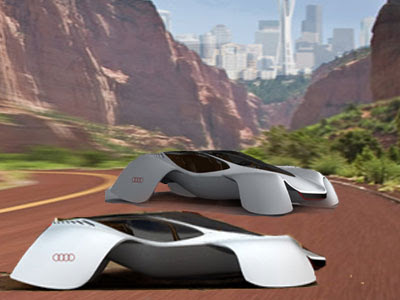
2009 Audi Avatar concept Car
2009 Audi Avatar concept Car
The wheels of the Avatar are housed inside the car's four 'legs'. The legs are constructed from a deformable material which allows it to change shape when the wheel is turned. To increase the vehicle's agility and handling, the Avatar features a four-wheel-steering system. The front wheels provide most of the steering, while the rear wheels can turn up to 10 degrees.
Labels: 2009, Audi, Concept Car, Design Car, Electric Car, Super Cars
2011 McLaren MP4-12C Super Sports Concept Car pure McLaren, Powered by a twin-turbocharged 3.8 litre, V8 Engine
2011 McLaren MP4-12C
The independent car division based at the McLaren Technology Centre in Woking, England,the McLaren MP4-12C is revealed as the first in a range of high-performance sports cars from McLaren Automotive.The 12C, and future models within the range, will challenge the world's best sports cars, benefiting from the expertise and virtuosity of the McLaren Group.
Through a rich modern history, McLaren's automotive division has already built the world's most critically acclaimed supercar, the McLaren F1 (1993-1998) and the world's best-selling luxury supercar, the Mercedes-Benz SLR McLaren (2003-2009). McLaren Automotive now looks to the future with a new range of revolutionary sports cars.
At its heart, the McLaren MP4-12C features a revolutionary carbon fibre chassis structure, the Carbon MonoCell: the first time a car in this market segment is based around such a strong and lightweight racing car engineering solution and the first time any car has ever featured a one-piece carbon fibre structure.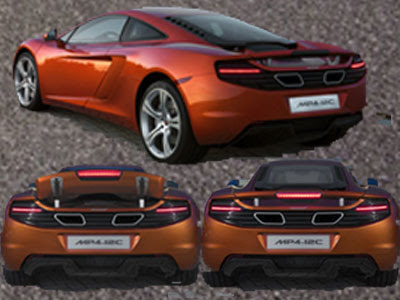

2011 McLaren MP4-12C
Martin Whitmarsh : "McLaren has for years offered a potent mix of race car and road car technologies. This combination of McLaren's performance heritage, and future demands on what is expected of high performance sports cars in the 21st century, gave us a head-start when we embarked on this project. The 12C, and future variants, draws on the spirit of Formula 1 and delivers real-world technological advances."
The first car from the new company, the McLaren MP4-12C, is a high performance two-seat mid-engine model in the 'core' sports car market segment for cars costing between £125,000 and £175,000.It goes on sale through a dedicated, worldwide retailer network in early 2011.
All the parts of the McLaren MP4-12C are bespoke and unique to this car. Everything from the engine right down to the tailor-made switches and buttons is pure McLaren: nothing has come from another manufacturer's parts bin.
The first car from the new company, the McLaren MP4-12C, is a high performance two-seat mid-engine model in the 'core' sports car market segment for cars costing between £125,000 and £175,000.It goes on sale through a dedicated, worldwide retailer network in early 2011.
All the parts of the McLaren MP4-12C are bespoke and unique to this car. Everything from the engine right down to the tailor-made switches and buttons is pure McLaren: nothing has come from another manufacturer's parts bin.
The 12C is powered by a bespoke McLaren 'M838T' 3.8 litre, V8 twin-turbo engine producing around 600bhp, driving through a McLaren seven speed Seamless Shift dual clutch gearbox (SSG). It is targeting not only new standards for power and performance in its sector, but also class-leading fuel economy and CO2 emissions; supported by McLaren's experience of active aerodynamics to aid cooling, grip, handling and road holding.

2011 McLaren MP4-12C
"The 12C is all about performance," said Sheriff. "And in McLaren, we have a very broad definition of performance. We don't just look at the traditional one-dimensional parameters like top speed, we focus equally on useable measures such as in-gear acceleration times, braking performance in all conditions, and efficiency of power delivery combined with the lowest possible fuel consumption and CO2 emissions. Sure, 12C is very fast, but it is also the most efficient, most driveable high-performance sports car in the world.
Thorough engineering and market research led to concept development and a clear decision in favour of a mid-engined two door high performance sports car. Intensive work was carried out in the wind tunnel and the driving simulator to ensure that the new car would inherently have superb dynamic qualities.
The McLaren MP4-12C design follows similar principles to McLaren's Formula 1 cars, and the legendary McLaren F1, where everything is for a reason and all lines, surfaces, and details are designed with a job in mind as much as styled. This ensures that the 12C communicates its engineering through its styling and will remain timeless as a piece of automotive design.
"By the time the 12C is launched in 2011 we expect the economic conditions to be much improved. We have already seen significant interest in the car and the supply of the 12C will be relatively scarce; in its first year we plan to produce just 1,000 cars which represents only 3.5 per cent of the 'core' market," explained Antony Sheriff.

2011 McLaren MP4-12C
The McLaren MP4-12C is powered by a twin-turbocharged, 3.8 litre 90° V8 engine - the 'M838T'. This marks the start of a new era in 'core' segment sports cars - smaller capacity, lighter weight, higher efficiency and more economical power units. The engine has the highest specific power output in its segment which, when allied to its low weight carbon composite chassis, delivers exemplary power- and torque-to-weight ratios.The McLaren engine revs to 8,500rpm, has quick transient throttle response and delivers its abundant torque throughout the rev range. A staggering 80 per cent of torque is available at below 2,000rpm, ensuring great driveability and no need to floor the throttle to deliver performance.
The McLaren MP4-12C has been designed around a demanding mechanical package that puts emphasis on aerodynamics, compact dimensions, performance and efficiency, practicality and comfort. Although the design of the 12C was driven by aerodynamics, it aims to remain contemporary and elegant throughout its lifetime as well as distinctive among its peers.
"The 12C design was therefore led by aerodynamics. At McLaren we have been able to use the Formula 1 techniques and the huge expertise that the company has amassed at the pinnacle of the sport," explained Stephenson.

2011 McLaren MP4-12C
Aerodynamic efficiency drove the 12C's design. High downforce helps maintain traction, cornering ability and stability while low drag aids top speed and acceleration. It has a completely flat underbody and smooth upper body surfaces to yield a highly effective drag coefficient and generate very high levels of balanced downforce at high speed.
Labels: 2011, Concept Car, McLaren, Spors Car, Super Cars, Super Sports Car
The search for the fastest car in the world title is still far from complete. If the Bugatti Veyron seems to be unbeatable with its 1001 HP and more than 400 km / h, it was the South-South cooperation Ultimate Aero and pushed the bar a little higher, at exactly 413.83 km / h with its HP 1199 and 1247 kg. Now, British car manufacturers want to regain the crown from the possession of the McLaren F1 in a manner very convincing, more precisely with the TKR Keating. Since there is no official data on the performance has been made available on that day, you can imagine what 1190 kg and 1500 hp supercar can do, but you do not have much imagination to the records May rapidly in dust…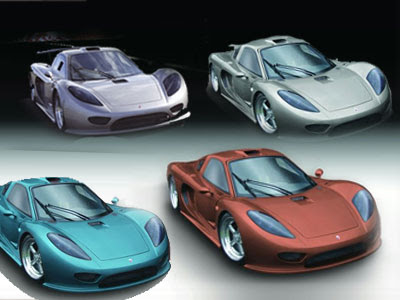

Keating TKR/SKR Super Cars
The new car version and its soft, the Swedish kroner, were last Wednesday in South Portland, United Kingdom. The two are on a steel space frame structure, but it allows a structure made of carbon fiber to support the weight even more. The bodies are made of fiberglass, carbon fiber, but also the facilities are available as an option. These vehicles are Keating 4.31 m long, 1.87 m wide and 1.15 m in height. The British automobile manufacturer is already orders for them, but the supplies did not occur by the end of the year. No hurry, because the customers have to wait for their luck in any case: SKR and the TKR is being built in a limited quantity to them and to ensure that only quality standards.

Keating TKR/SKR Super Cars

Keating TKR/SKR Super Cars
In the first of two runs on the Salt Lake Flats in California last month, the remarkable 7.0 litre, 1800 BHP Keating TKR smashed the current record, adding an extra 3 mph to the top speed of existing title holder, the Shelby Aero TT.The TKR will probably have the LS7 engine as its base, but two turbochargers are expected to make its power skyrocket to 1,500 hp. This number can be even higher, since the supercar is still under development.Now the Manchester based company must do it again to ensure entry in the Guinness Book of World Records.
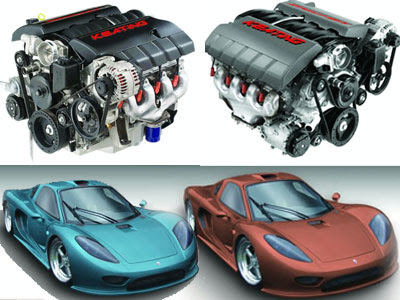
Keating TKR/SKR Super Cars
But before it returns to California, the breathtaking Keating TKR will make its MPH show debut in London tomorrow in front of capacity crowds.
Tony Keating, founder of Keating Supercars, said: “The Keating TKR realises our ambition to take on the world’s finest supercars and win. This car rivals them all for looks, handling, performance and exclusivity. And best of all, it’s British.”
Labels: Fast car, Keating, Keating TKR, Super Cars, Super Sports Car
The Marussia B1 is a Russian made supercar developed entirely by a team of Russian designers and engineers.The B1's aerodynamic bodywork was developed courtesy of a competition which invited young Russian designers to submit their concepts to the company. The winning design would then be used to help shape the final product.The defining characteristics of the Marussia B1's exterior design are the aggressive, sharp lines and the two-tone paintwork. And despite the B1 being Marussia's first attempt at a sports car the end result is appealing from a styling point of view.
Unfortunately despite the supercar looks the Marussia B1's drive train is not up to supercar levels. Or even premium sports car numbers. Located in a mid-mounted position is a 3.5 litre V6 which produces 245 horsepower and 330 Nm of torque @ 3,600 rpm. Marussia claim this is good for a 5 second 0-60 time, and a 155 mph top speed. Thankfully however the company is working on developing different drivetrain options which should help the performance match the appearance. Marussia B1 Russian supercar
Marussia B1 Russian supercar
 Marussia B1 Russian supercar
Marussia B1 Russian supercarThe interior of the Marussia B1, which was developed through a collaboration between Italian and Russian designers, features a pair of reclining deeply-bolstered sports seats and a squared off three-spoke sports steering wheel. The dash of the Marussia B1 features three separate LCD displays which provide information for both driving functions and the entertainment systems. The displays are touch screen, but the functions can also be controlled with the help of a joystick mounted on the centre console.The whole interior can be upholstered in a variety of different colors and finishes to suit the owners tastes.
Labels: Marussia, Spors Car, Super Cars, Super Sports Car
Mansory Chopster Porsche Cayenne
Based on the Porsche Cayenne Turbo S, the Mansory Chopster features a new body styling, aerodynamic elements, performance upgrades and various interior refinements.MANSORY, the refining specialist for super sports cars has worked on the latest generation Chopster – a holistic SUV artwork with the exclusiveness and precise processing of a Swiss clockwork that will make its world debut at the 2009 Frankfurt Motor Show.
The MANSORY Chopster Porsche Cayenne is powered by a modified V8 engine that develops 710 hp / 522 kW and 900 Nm of torque. The top speed of the MANSORY Chopster Porsche Cayenne, as the tuner says, is 302 km/h. The MANSORY Chopster Porsche Cayenne comes with a sport exhaust system with an optimised off-gas stream, a racing header and a four-pipe baffler, a larger turbo, a re-programmed ECU and a new air intake.
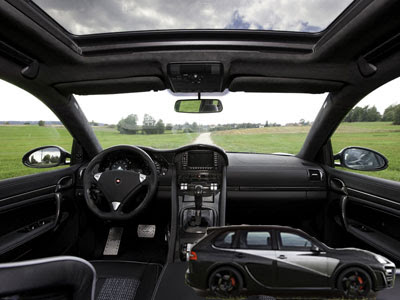
Mansory Chopster Porsche Cayenne
The fully forged 11x23 inch mono block rims in turbine design and the Dunlop Sport Maxx GT-tyres sized 315/25/23 perfectly fit under the broadened Chopster wing. By the Mansory sport module for air suspension control, the XXL-wheels are additionally enhanced. If desired, the SUV´s centre of gravity can be lowered by 45 millimetres.
Whether front- or rear apron, doors, bonnet or the wings which broaden the cars by 80 millimeters – all components are formed out of carbon and hardened under strong pressure and high temperatures in the autoclave.
The interior is lined with most delicate materials rendering a comfortable feeling. The leather of the Chopster interior is extremely hard wearing, but yet enormously soft and finished by expert hand. For the Chopster interior, the MANSORY interior designers only use flawless leather skins and accentuate them with discreet decorative stitches.
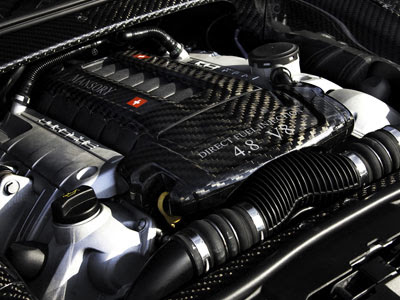
Mansory Chopster Porsche Cayenne
Equipped with two monitors in the centre console as well as DVD-player and laptop with internet connection, the car offers everything the clientele desires. The newly designed airbag sports steering wheel, the aluminium pedals and the carbon fibre applications perfect the exquisite overall impression in the Chopster. MANSORY achieved the perfect symbiosis of dynamic functionality and a luxurious atmosphere.
Labels: Mansory, Spors Car, Super Cars, Super Sports Cars
MANSORY Stallone Ferrari 599 GTB Fiorano
MANSORY Stallone – an exquisite power pack based on the Ferrari 599 GTB Fiorano
As a specialist for customisation of Aston Martin, Bentley and Rolls Royce automobiles, MANSORY has long been an institution. Now, the company from Brand in Bavaria has tackled the Ferrari 599 GTB Fiorano. With luxurious as well as sporty modifications, MANSORY proves that the company also has a clear understanding of customising Italian super sports cars. Especially light body components made of carbon, a powerful increase to the engine performance and an interior covered with the finest ostrich leather fulfil the car desires of the exclusive clientele. MANSORY Stallone Ferrari 599 GTB Fiorano
MANSORY Stallone Ferrari 599 GTB Fiorano More Bounce for the Italian Stallion
MANSORY pays special attention to performance optimisation with which the car from Maranello made the sprint from zero to 100 kph two tenths faster than the series version (3.7 seconds). The propulsion is only over at 340 kph. Thus the modification, called the Stallone, impressively fills the gap to the fast, 350 kph sports car brother, the Enzo. The engine components newly developed by the MANSORY technicians are responsible for this. The performance kit includes high-performance compressors and custom made intercooling. The supercharging of the V12 power train is supported by a sport air filter with higher air throughput as well as modified control electronics. This increases the performance of the large 6.0 litre twelve cylinder engine from 620 to 720 HP. The torque increased by an additional 92 Nm. The sport rear muffler made of stainless steel underscores the sporty appearance of the MANSORY Stallone with its impressive sound.
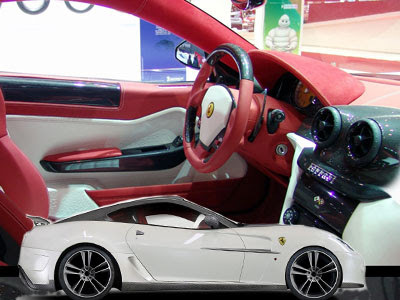
MANSORY Stallone Ferrari 599 GTB Fiorano
Perfect Symbiosis: the MANSORY forged turbine-wheel and the Dunlop Sport Maxx
In order to accommodate the increased performance, the company developed especially light forged wheels with a 9 x 20 inch size for the front axle and 11.5 x 21 inch for the back axle.
11.5 x 21 inch for the back axle. At only 13 kg for one of the front axle rims, the MANSORY wheel is one of the absolute lightweights. By using weight-saving aluminium alloys and with the resulting reduction of the unsprung mass, the acceleration, breaking distance as well as the handling are improved considerably. The SP Sport Maxx model of Dunlop high-performance tyres developed together with MANSORY are a perfect match. The front tyres are 255/30 and the back ones are 325/30. The suspension spring also creates a sporty flair, which lowers the centre of gravity of the super sports car by 30 millimetres and moreover emphasises the wheel/tyre combination even more.
The most exquisite materials, processed with the greatest traditional craftsmanship distinguish the interior of the MANSORY Stallone. The leather used by MANSORY for the interior is particularly durable but still extremely soft. The unique grain of the unusual leather combined with the stylish ornamental seams and the exposed carbon appliqués convey both elegance as well as sportiness in the interior. Masterful handiwork, individual styling, and the highest quality is found wherever one chooses to look. The pedals made of aluminium, the illuminated door entry strips and the ergonomically redesigned sport steering wheel create additional optical highlights.
Labels: Mansory, Sports Car, Super Cars, Super Sports Car
The Bugatti EB110 Super Cars
The Bugatti EB110, named to commemorate 110 years since Ettore Bugatti's birth, was the first car produced after the rejuvenation of Bugatti. The Bugatti EB110 was a superb aluminium bodied mid-engined V12 supercar. The EB110's extroverted design was penned by Marcello Gandini (also responsible for the Lamborghini Countach and Lancia Stratos), it received praise and dislike in similar measures.
Under the skin the Bugatti EB110 was mechanically advanced, it featured a 60 valve 3.5 litre V12 engine fitted with four turbochargers. This unit developed anywhere between 560 to 611 horsepower, and mated to a 6 speed AWD system it made the Bugatti EB110 a formidable driving tool.
As well as the 'standard' EB110, Bugatti created a lightened and more powerful 'SS' version. In total somewhere between 150 and 160 EB110 supercars were produced.
Labels: Bugatti, Super Cars
Subscribe to:
Posts (Atom)
